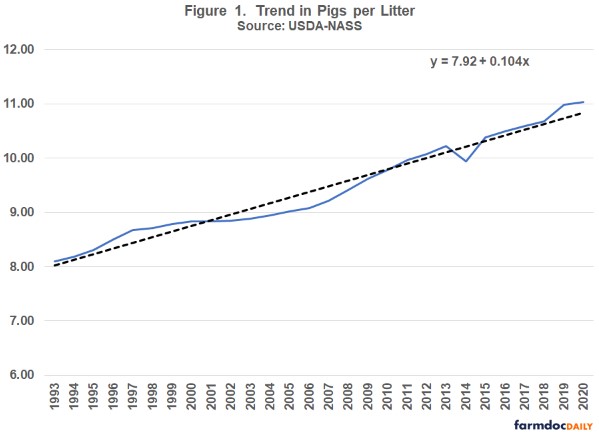By Michael Langemeier
Center for Commercial Agriculture
Purdue University
Key performance metrics for swine production include feed conversion, litters per sow per year, pigs per litter, and pounds of pork produced per sow per year. All of these metrics have improved dramatically over time. Improvements in production performance are critical to controlling production costs and for the industry to remain competitive in comparison to swine producers in other countries and competing meats. This article examines long-term trends in pigs per litter.
Pigs per litter data for the U.S. are available from USDA-NASS on a monthly, quarterly, and annual basis. Figure 1 illustrates actual and predicted pigs per litter from 1993 to 2020. A simple linear trend was used to predict pigs per litter for each year. The annual growth rate in pigs per litter was 0.104 pigs per year or 1.10 percent. This may seem small, however, over the 28-year period, this equates to an increase of 2.93 pigs per litter or an increase of approximately 36.2 percent over the 1993 to 2020 period.
Production performance, measured using pigs per litter, has been particularly strong in the last few years. As evident in Figure 1, since 2015, pigs per litter have been above the trend line. This was particularly true in the last couple of years. Actual and predicted pigs per litter were 10.98 and 10.66 in 2019, and 11.03 and 10.76 in 2020. In other words, pigs per litter were from 0.27 to 0.32 pigs above the long-run trend in the last two years.

Improvements in production performance, such as litters per sow per year and pigs per litter, have impacts on the number of sows needed to supply the domestic and export markets. Obviously, if pigs per litter had not increased over the last few decades, we would need a much larger sow herd. In addition to production performance, the increasing market weight of barrows and gilts has impacted the size of the sow herd needed to supply our markets. To provide some perspective on the importance of production performance and market weights, we will contrast the growth rates in sows farrowed, pig crop, and swine production in pounds (USDA-NASS). The annual growth rate in the U.S. sow herd during the 1993 to 2020 period is only 0.02 percent, and is not significantly different from zero. In contrast, the annual growth rate in the U.S. pig crop (1993 to 2020) and U.S. swine production (1993 to 2019) are 1.25 percent and 1.94 percent, respectively. In 1993, the pig crop (swine production) was 97.3 million head (23.8 billion pounds). The pig crop in 2020 was 139.4 million head, while swine production in 2019 was 40.5 billion pounds. To summarize, we have increased U.S. swine production by 70 percent without increasing the number of sows. In terms of per sow production, pounds produced per sow increased from 1,979 in 1993 to 3,189 in 2019.
In closing, pigs per litter has increased at a rate of 0.104 per year since 1993. Another way of stating the same thing, the annual growth rate of pigs per litter in the U.S. was 1.10 percent from 1993 to 2020. Continued improvements in production performance will help ensure the U.S. swine industry remains competitive.
Source : illinois.edu